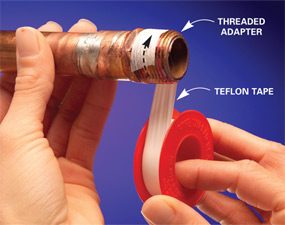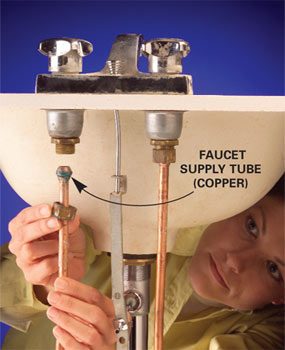
...................................................................................................
Leaks in Plumbing
Joints
Foolproof methods for connecting valves, faucets and sinks,
and drain parts.
The best time to
fix a plumbing leak is before it happens, by properly connecting water supply
and waste line fittings. Learn the tricks that pros use to make leakproof
connections.
By the DIY experts
of The Family Handyman Magazine
Use two types of Teflon pipe joint compound on threaded
joints
Photo
1: Wrap threads with plumbers tape
Wrap
the plumbers tape around the pipe clockwise.
Why
use plumbers tape and pipe joint compound
Connections
that rely on threaded pipes and fittings are prone to leaks if they’re not
sealed with either Teflon tape or Teflon pipe joint compound. Careful plumbers
use both pipe joint compound and teflon on every joint for extra security.
They don’t want to come back.
Start
by wrapping the male threads with Teflon tape (Photo 1).
With
the end of the threaded pipe facing you as shown, wrap the plumbers tape
clockwise. Usually three layers is enough.
Once
in a while, you’ll run into a loose fitting that requires four or five wraps.
Stretch and tear the tape to complete the wrap.
Spread
a thin layer of Teflon pipe joint compound over the tape (Photo 2).
If
you’re working with plastic pipe, choose Teflon pipe joint compound that’s
compatible with it. Then start the threads by hand before tightening the
connection with wrenches (Photo 3).
Wipe
away the excess pipe joint compound.
Lubricate the ferrule on compression joints
Photo
1: Wipe pipe joint compound
Lubricate
the ferrule and brass ring with pipe joint compound.
Compression
joints are most common on shutoff valves, although you find them on other
fittings as well. They have a brass or plastic ring (ferrule) that’s compressed
into a recess when you tighten the nut, forming a seal.
Lubricating
the pipe and the ferrule with a bit of Teflon pipe joint compound (Photo 1)
helps the ferrule slide along the pipe and squeeze tightly into the recessed
fitting with less wrench pressure (Photo 2).
Tighten
compression fittings firmly with two wrenches to crimp the ferrule onto the
pipe (Photo 3). Also make sure the pipe or tube goes straight into the fitting.
Misalignment
will cause a leak. If the fitting leaks after you turn on the water, try
tightening the nut an additional one-quarter turn. This usually stops the leak.
Align slip joints precisely for a tight seal
Photo
1: Lubricate pipe
Pipe
joint compound helps lubricate and seal waste line connections.
Joints
on chrome trap assemblies rely on rubber slip joint washers for the seal, which
often leak.
If
you’re reassembling a chrome trap, buy new slip joint washers and nuts.
However,
new washers sometimes stick to the pipe, causing them to twist or distort as
you push them tight with the slip joint nut.
To
avoid this, lubricate the drain tubing and slip joint with a little pipe joint
compound (Photo 1). The compound helps the washer slide smoothly and creates a
tighter seal.
Start
the slip joint nut by hand, and twist it on until the threads are engaged
correctly. Hand-tighten all joints first (Photo 2). Then adjust the trap parts
until they’re aligned and pitched slightly for drainage.
This
is key; a misaligned joint will leak, even with new washers. Finally, use a
large slip joint pliers to tighten the nuts an additional half turn.
Plastic
trap parts use hard plastic slip joint washers for a seal. Make sure the flat
part is against the nut with the tapered side facing the fitting.
Choose flexible supply tubes
Photo
1: Solid copper supply lines
Avoid
solid copper or chrome supply lines. They’re difficult to get right unless
you’ve had lots of experience with them.
The
skinny copper or chrome supply tubes used to connect faucets and toilets (Photo
1) are tricky to cut, bend and align.
But
you don’t have to put up with them. When you’re replacing a faucet or toilet,
use flexible supply hoses with a braided covering instead (Photo 2).
They
have rubber gaskets at each end and don’t require much force to seal. They’re
available in many lengths and are flexible enough to fit almost any configuration.
The
only trick is buying a connector with the correct size nuts on the ends. Take
your old tubing and the nuts on each end along with you to the store to be sure
of an exact match.
Start
the nuts carefully and hand-tighten. Then tighten an additional half turn
(Photo 2). Avoid overtightening. It’s easy to tighten the nuts a little more if
the joint leaks.
Required Tools for this Project
Have
the necessary tools for this DIY project lined up before you start—you’ll save
time and frustration.
·
Adjustable wrench
·
Slip joint pliers
·
Wrench set
Required Materials for this Project
Avoid
last-minute shopping trips by having all your materials ready ahead of time.
Here’s a list.
·
Flexible supply tubes
·
Teflon pipe joint compound
·
Teflon tape
By the DIY experts of The Family Handyman Magazine






No comments:
Post a Comment